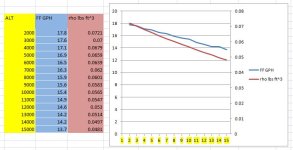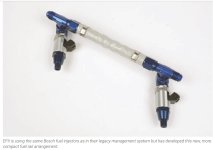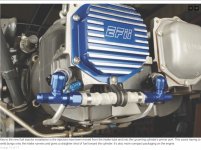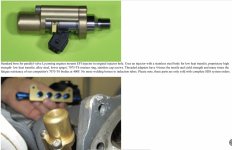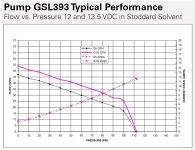MikeWhiskeySierra
I'm New Here
Had the chance to tour FlyEFII at Cable Airport in Upland CA (greater Los Angeles area) this weekend with a few other interested builders and figured I’d share my impressions and some of the answers Robert (the founder) was able to give to our numerous questions. Overall, it was a great tour and I was impressed with the system. Additionally, Robert and his business partner Lylah run a professional shop - I was impressed with the relatively advanced manufacturing tools they had and how they've managed to squeeze their entire business into a single hangar. Thanks for sharing so much of your time with us, Robert!
This is a pretty long post, and I know this is a popular topic - I hope it will help others get a jump start on their own research into electronic fuel injection and ignition and also foster some healthy debate on the pros and cons of the architecture as a whole and FlyEFII/System32 specifically. Judgement will always be an element of an engineering decision, but the best rationale is based off data – I think EFII is an inevitable future for general aviation just like how it was for cars, and the experimental community has the ability to help bring this technology to the mainstream and continue to drive our powerplants into the modern age.
Bottom line up front: I think the FlyEFII System32 has some theoretical downsides compared to a conventional magneto system that at least plausibly could result in engine failure where the conventional system would keep chugging along, but the system is designed to meet or exceed the reliability we expect in single piston engine airplanes, and we need more hard data and rigorous analysis to make a real comparison. I suspect this system is at least as reliable as any well-maintained conventional system, and also likely improves system reliability through reducing pilot workload and margin for error with manual mixture control (in addition to nice-to-have efficiency and maintenance/engine life improvements). I plan on installing it in my RV-14 for cross-country IFR operation that will take me over the mountains.
Note: I use FlyEFII/System32 somewhat interchangeably, but EFII is generally used in reference to the generic architecture – sorry for any confusion! Also, I haven’t had a chance to dive as deep into the competitors, so this is admittedly an incomplete review of the EFII landscape.
Quick reference to get up to speed:
This is a pretty long post, and I know this is a popular topic - I hope it will help others get a jump start on their own research into electronic fuel injection and ignition and also foster some healthy debate on the pros and cons of the architecture as a whole and FlyEFII/System32 specifically. Judgement will always be an element of an engineering decision, but the best rationale is based off data – I think EFII is an inevitable future for general aviation just like how it was for cars, and the experimental community has the ability to help bring this technology to the mainstream and continue to drive our powerplants into the modern age.
Bottom line up front: I think the FlyEFII System32 has some theoretical downsides compared to a conventional magneto system that at least plausibly could result in engine failure where the conventional system would keep chugging along, but the system is designed to meet or exceed the reliability we expect in single piston engine airplanes, and we need more hard data and rigorous analysis to make a real comparison. I suspect this system is at least as reliable as any well-maintained conventional system, and also likely improves system reliability through reducing pilot workload and margin for error with manual mixture control (in addition to nice-to-have efficiency and maintenance/engine life improvements). I plan on installing it in my RV-14 for cross-country IFR operation that will take me over the mountains.
Note: I use FlyEFII/System32 somewhat interchangeably, but EFII is generally used in reference to the generic architecture – sorry for any confusion! Also, I haven’t had a chance to dive as deep into the competitors, so this is admittedly an incomplete review of the EFII landscape.
Quick reference to get up to speed:
- I read some good Kitplanes articles for reference before the tour, these were a good primer:
- EFII overview (2018): https://www.kitplanes.com/under-new-management/
- Electronic ignition overview (2012, somewhat dated)
- There’s more detail in the FlyEFII Installation Manual, Bus Manager Installation Manual, and the User Manual (have to email Robert for it), but here’s a high level overview. I’m building an RV-14 with a 4-cylinder IO-390, so some of the specifics are tailored to that application – for example, add another ignition coil for a 6-cylinder IO-540:
- Fuel injection:
- Redundant fuel pump pair, commercial pumps mounted in custom-machined housings.
- Constantly pressurized cold fuel supply rail (plus fuel return line), standard stainless steel braided, teflon lined hoses.
- Single electronically actuated solenoid fuel injector per cylinder, fires into air intake through cylinder head. Automotive injectors mounted in custom-machined housings for mounting to the cylinders.
- Ignition:
- 2 automotive iridium spark plugs per cylinder, each ECU powers a single spark plug per cylinder.
- 2 ignition coils, each coil powered by a single ECU and each coil powers a single spark plug per cylinder
- Electronics
- Professionally outsourced circuit boards mounted in custom-machined ECU housing, some other fancy features like gold EMI plating and RF filters.
- Two redundant Engine Control Units (ECUs)
- Critical sensors: 2 automotive manifold air pressure transducers, 1 custom RPM sensor via magnetic pickup and magnets precision-installed in the flywheel, and 2 intake air temperature sensors (less important than MAP and RPM).
- Non-critical sensors: 1 engine temperature sensor installed in unplugged port in the rear cylinder (others plugged), 1 throttle position sensor, optional oxygen sensor for info-only air-fuel ratio
- Digital controller/display – same hardware as Garmin G5
- Harnesses built in house
- System tested in house before shipment
- Power supply
- 2 batteries
- 1 alternator minimum, 2 recommended
- Custom power bus manager recommended, 2 redundant busses (1 critical, 1 non-critical), emergency backup direct-wired switch for third level of redundancy. Bus manager has a very large range of acceptable voltage input, increasing likelihood of continue operation in the event of alternator/battery/voltage regulator issues.
- Fuel injection:
- Pros
- No mixture control knob – reduced pilot workload and automatically optimized fuel delivery across the operational envelope for both efficiency and safe operation from low idle to wide open throttle.
- Variable spark timing and automotive spark plugs (large, efficient spark) for optimized combustion efficiency at all throttle settings and operational conditions (namely altitude), which reduces fuel consumption on the order of 1 GPH. Not revolutionary, but saves a decent amount of money and adds endurance.
- Inexpensive automotive spark plugs can be replaced for less cost than overhauling traditional massive electrode spark plugs.
- Reduced weight – I’m not sure the exact numbers, but it’s probably a few pounds.
- No risk of vapor lock during hot starts since the system has a fuel tank return line. Hot starts can be achieved on almost any engine, but it typically requires a patience-testing procedure.
- No risk of inadvertent starts, even if the prop is turned – prop needs to be turning at least 50 RPM for the system to engage.
- Customizable fuel mapping for precise control of engine operation across all operating conditions. Fuel delivery can be adjusted for all cylinders at once and also tuned for individual cylinders, on the ground and in the air.
- System can save all operational data to an SD card for detailed review of data for troubleshooting and performance optimization.
- Electronically-controlled ignition system has a built-in rev limiter to prevent over-speed.
- Flexible fuel choices – operates with 100LL, 100UL, or auto gas. With the inevitable shift to unleaded fuel coming soon, this is a notable benefit to me.
- Very little maintenance, fuel filter replacement every few hundred hours, not sure about pump replacement interval but likely very infrequent, spark plugs typically have long life, etc.
- Cons
- System is electrically dependent, so there are failure modes where loss of power can result in the engine stopping.
- No provision to hand prop to start – not a huge deal, but notable.
- Manual intervention required to switch over to the redundant ECU system if there is a failure of any single-fault-tolerant critical component in the primary control loop (ECU, MAP/IAT sensor, etc.) – this can cause the engine to stop, though the propeller would likely remain spinning and restart would likely be quick once fuel and spark are returned.
- Relatively complex compared to conventional magneto system.
- Automotive components: the system incorporates several automotive components such as the fuel injector, MAP/throttle/temp sensors, etc.
- I asked Robert to counter a common argument I’ve seen that, specifically within the context of EFII, automotive components are less reliable than their aviation counterparts. His opinion is that this is mostly based on perception, and isn’t really founded on first principles or hard data (and within the EFII ecosystem, there aren’t really any systems that haven’t evolved using automotive parts). He had some issues with component reliability in the early design, but upgraded the hardware to what is seen as the top of the line in the auto world, and hasn’t seen any significant issues since. The environments of a race motorcycle or car engine are similar to an aviation application, so I think this is a reasonable take.
- In my opinion, concrete reliability data (e.g. # critical component failures per 1,000 hours operation) is necessary to evolve this debate from judgement-based decisions to objective evaluation.
- Some other thoughts:
- Auto hardware benefits from large scale implementation and has lots of data to inform the design, particularly for high-end applications where designers care about their reputation and performance.
- The hardware incorporated into System32 is based on Robert’s personal experience with their effectiveness and reliability – while somewhat anecdotal, 30 years of experience shouldn’t be dismissed.
- Design stability
- Some components changed from the initial design, but the design has been locked in for a while now, and Robert says no changes are planned. Potential certification opportunities may bring in new requirements, but nothing that Robert thinks is critical for operation.
- Failure tolerance architecture/philosophy
- System32 is designed for single-fault tolerance in most cases – failure of the manifold air pressure sensor being read by ECU1 will cause failover to ECU2, and if any critical sensor fails on that system, the system can’t be expected to operate correctly. In the interest of simplicity, the ECUs are not wired to take input from both of the redundant sensors.
- This is an area where I had some difficulty adjusting my expectations. My day job is propulsion engineering for rocket engines - the systems I work on are completely autonomous and carry very high value payloads, so the architecture is designed to maximize the probability of successful engine operation with secondary concern for cost and complexity. Most critical systems use triple-redundant sensors and electronics, and many (though not all) systems are two-fault-tolerant or better. A common architecture in spaceflight is to use three independent ECUs which have access to all sensors on board, but this does incorporate significant additional complexity.
- In my opinion, single-fault tolerance is at least a theoretical shortcoming of the FlyEFII system, and does give me some pause when I think about IFR operation where engine failure could be fatal. I think this system could be designed to be more reliable with acceptable complexity; however, as a product for general aviation single piston engine airplanes where we accept single point failure modes, I think Robert has struck a reasonable compromise between reliability, cost, and complexity. Engine failure scenarios are always possible and are a standard part of mission planning, so I don’t think EFII is fundamentally different than a conventional system. In reliability engineering terms, I think improvements would take you from maybe 3 sigma to 4+ sigma, but it's probably not going to make a noticeable difference across any of our flying careers.
- Critical sensors: RPM, manifold pressure, inlet air temperature*
- *Inlet air temperature is somewhat less critical, will result in a shift in fuel distribution but not a hard failure
- Loss of RPM or MAP is unknown territory, unclear what would happen and it doesn’t sound like it’s been tested. It would be nice if failure testing data was available so we can know what to expect.
- 2x ECUs, but each only mapped to a single sensor – each ECU will fail if one of the critical sensors (RPM or MAP) fails
- Power bus manager actually has 3x redundancy
- Essential bus (ignition/injection) runs off one alt, two batteries
- Main/non-essential bus runs off one alt, two batteries, on a separate circuit
- Emergency power delivery can be activated via switch and provides a direct path from batteries to hardware to get the plane to the nearest airport.
- Fuel maps/tuning
- The system comes pre-loaded with a fuel map based on your engine (IO-390, IO-540, etc.). This map should be pretty close based on normal hardware/operational variability, but many people choose to do fine tuning during preliminary engine dyno testing/run-in/flight test/etc.
- System is completely open – you have the power to do whatever you want, for better or worse!
- The system allows you to actively control fuel trim in four ways:
- All cylinders via a control knob
- Mapping updates vs. RPM (more common for general mapping) or vs. MAP (rarely used, often just to prevent backfiring when at low throttle coming in to land)
- Cylinder-specific mapping up to +/- 9% (limits set so you can’t get into a dangerous situation, fuel delivery isn’t always the issue though it may seem to be… Robert told us of an issue he saw where an asymmetric EGT sensor orientation caused the readings to appear different even though they were likely very similar)
- Updating the mapping at any point (ground or flight) is stored in the system – it will not reset when you power cycle (keep a record of original mapping!)
- Fuel return line
- Because the system relies on a constantly pressurized fuel rail to feed the injectors, you need to install a return line to the fuel tanks so the pumps aren’t running deadheaded (zero flow), which is a typical requirement for pumps to avoid damage. This seems like it will add about as much work as running the normal feed line from the tank.
- Because there’s a large pressure drop across the fuel pressure regulator from the supply line to the return line, the return line will be filled with vapor – Robert said he did bench testing that indicated the return line won’t feed bubbles into the supply line as long as the return line isn’t underneath the supply line (to avoid bubbles floating up and being ingested) and they’re separated by at least 3”. In practice, this seems easy to accomplish.
- Filters
- The System32 kit includes two filters: one pre-filter upstream of the pumps, and one downstream of the pumps, upstream of the injectors. Following best practices for filter design, Robert says these filters have much more surface area than some other popularly used models – higher surface area makes it less likely to clog and reduces pressure drop across the filter (and likelihood of filter blowout).
- Pre-filter: Coarse tank outlet filter to prevent large particles from damaging the fuel pumps – this is a high surface area, removable stainless steel mesh filter that can be backflushed to determine how much debris is in the tanks. Robert said he recommends replacing this in the first ~50 hours of operation of a newly built plane for good measure (since some FOD is inevitable), but subsequent installs last hundreds of hours.
- Post-filter: fine paper filter to prevent debris from clogging the fuel injectors.
- Fuel injectors
- Automotive, mature technology
- Housings are plastic, not necessarily tolerant of very high temperatures, but likely operate within their design environment.
- Seems like the aviation environment would normally be similar to an automotive environment – if there was a fire, the hardware could be damaged, but you’re shutting down the engine at that point anyway.
- Very tight fit in the IO-390, need to modify oil fitting thread (make deeper) and then install the injector housing, but not a huge deal.
- NPT threads need pipe dope or Loctite, no real difference but need to be careful about FOD and never use Teflon tape.
- Fuel rails
- Custom length -6 AN fittings, stainless steel braided hose with Teflon liner, pretty standard.
- Flexible, minimal concern for fatigue compared to solid rails
Last edited:


